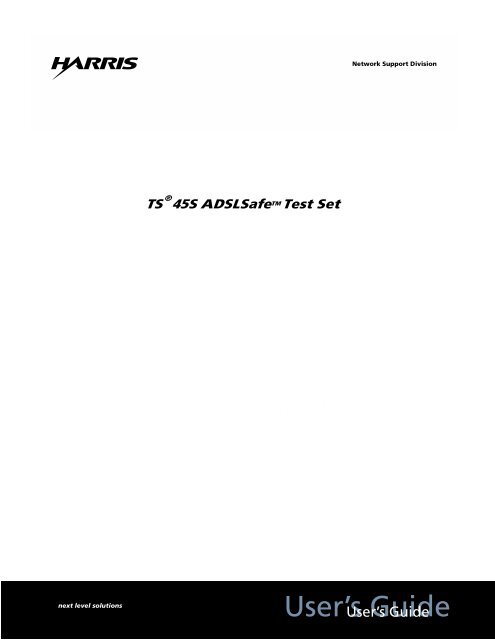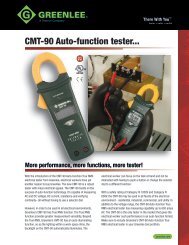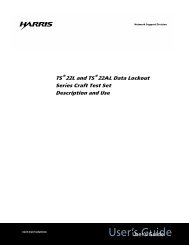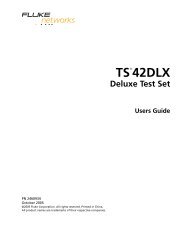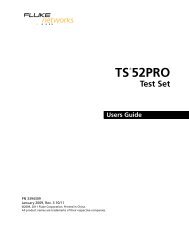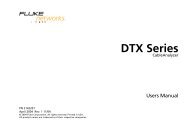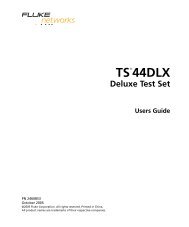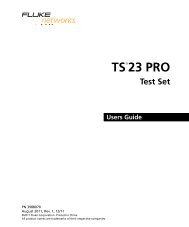Fluke Networks TS45S ADSL Safe test set users guide - Datacomtools
Fluke Networks TS45S ADSL Safe test set users guide - Datacomtools
Fluke Networks TS45S ADSL Safe test set users guide - Datacomtools
- No tags were found...
You also want an ePaper? Increase the reach of your titles
YUMPU automatically turns print PDFs into web optimized ePapers that Google loves.
Network Support DivisionTS ® 45S <strong>ADSL</strong><strong>Safe</strong> TM Test SetTechnical Manualnext level solutionsUser’s User’s Guide
No part of this publication may be reproduced, stored on a retrieval system, or transmitted, in any form or by any means electronic,mechanical, photocopying, recording, or otherwise, without the prior written permission of Harris Corporation. The use oftrademarks or other designations is for reference purposes only.NOTICEHarris Corporation makes no warranties about this document. Harris Corporation reserves the right to make hardware and softwarechanges to the product described within this document without prior notice and without obligation to notify any person of suchrevision or change.TRADEMARKSTS is a registered trademark of Harris Corporation.REGULATORY INFORMATIONWARNING: This equipment generates, uses, and can radiate radio frequency energy, and, if not installed and used in accordancewith the installation manual, may cause interference to radio communications. It has been <strong>test</strong>ed and found to comply with the limitsfor a Class A digital device pursuant to Part 15, Subpart J of the FCC rules, which are designed to provide reasonable protectionagainst such interference when operated in a commercial environment. Operation of the equipment in a residential area is likely tocause interference, in which case the user, at his own expense, will be required to take whatever measures may be required tocorrect the interference.Declaration of ConformityManufacturer:Importer:Signature:Print:Harris CorporationNetwork Support Division809 Calle PlanoCamarillo, CA 93012 U.S.A.Ed Zoiss, Director of Engineering_____________________________________________________________________________________________________________________________________________________________________Standards Used:FCC part 15CISPR 22EN300386-2:97 EMC, ESD DirectivesEN61010.1 (1993). <strong>Safe</strong>ty Requirementsfor Electrical Equipment for Measurement,Control,and Laboratory Use.CSA/CAN C22.2 No. 1010.1-92 <strong>Safe</strong>tyModel: <strong>TS45S</strong>Serial: ____________________Harris Corporation officially declares the <strong>test</strong> equipment listed above is in conformity with ElectromagenticCompatibility Directive 89/336/EEC and Low Voltage Directive 73/23/EEC based on <strong>test</strong> results performed in atypical configuration. This Conformity is indicated by the following symbols representing the European Communityand compliance organizations:C®USNetwork Support Division | 809 Calle Plano | Camarillo, CA 93012-8519 USAwww.<strong>test</strong><strong>set</strong>s.harris.com 1-800-437-2266next level solutionsii©2000 Harris CorporationWritten/Printed in USA. 0II-727880-002, Issue 3, July 2001
Contents■ <strong>Safe</strong>ty Information 1■ Introduction 2■ Design Features 2■ Physical Characteristics 3■ Controls and Indicators 4■ Audio Controls 4■ Keypad Controls and Indicators 5■ Power and Connections 7■ Battery 7■ Line Cords 7■ Operation 8■ Talk/Monitor Switch 8■ Operating the Test Set in Monitor Mode 9■ Operating the Test Set in Talk Mode 9■ Data Lockout Operation 10■ Data <strong>Safe</strong> Practices 11■ Lockout Override Operation 12■ Operating Your Test Set on <strong>ADSL</strong> 13■ Configuring Your Test Set 14■ Maintenance 16■ Replacing the Battery 17■ Replacing the Belt Clip 17■ Replacing the Line Cord 19■ Warranty 21■ Non-Warranty 21■ Return or Repair of Equipment 22■ Specifications 22iii
<strong>Safe</strong>ty InformationRead First Before UseWARNING:Means conditions and hazards may pose risk to user.CAUTION:Means conditions and hazards may damage the <strong>test</strong> <strong>set</strong>.The following IEC symbols are used either on the <strong>test</strong> <strong>set</strong> or in the manual:See Manual for detailsEarth GroundConformité EuropéenneIndustry Canada and U.S.<strong>Safe</strong>ty Approval<strong>TS45S</strong> Test Set 1
IntroductionThe <strong>TS45S</strong> Test Set is an analog <strong>test</strong> telephone used by installers, repairtechnicians, and other authorized personnel for the <strong>test</strong>ing of copper wire,voice subscriber lines. In addition to standard off-hook telephoneoperations (e.g., tone and pulse dialing), the <strong>TS45S</strong> has an on-hookMonitor mode which allows the operator to monitor line conditions withoutaffecting voice or data signals that may be on the line. The <strong>TS45S</strong> has abuilt in speakerphone allowing two-way conversation and freeing up theoperator’s hands for other tasks.In today’s telecommunications environment, a large number of subscriberlines carry both voice and data services simultaneously. The most commoncombination is <strong>ADSL</strong> with POTS. The <strong>TS45S</strong> incorporates unique circuitry(patent pending), which allows technicians to go off-hook to <strong>test</strong> the POTS(voice) portion of an active <strong>ADSL</strong> circuit without disrupting the <strong>ADSL</strong>. Inaddition, if the <strong>TS45S</strong> is accidentally connected to any subscriber dataservice, it will not disrupt the service.Design FeaturesTable 1 lists the design features of the <strong>TS45S</strong> series.Table 1. <strong>TS45S</strong> Series Design FeaturesFeatureData Detection in Monitor ModeData<strong>Safe</strong> TM in Monitor ModeData Detection and Lockout in Talk ModeData Lockout OverrideHigh Impedance MonitorHigh Voltage ProtectionLast Number Redial up to 23 digitsMicrophone MutePBX Pause KeyContinuous Polarity Indication in Talk ModeTwo-Way SpeakerphoneFeatureReceive-Only Loud SpeakerSpeed Dialing for ten 23 digit numbersTone and Pulse DialingHook FlashLow Loop Current TestField Replaceable Line CordLow Battery IndicationField Replaceable Belt ClipField Replaceable BatteryWeatherproof CaseSoftware Upgradeable2<strong>TS45S</strong> Test Set
RCLLOWBATTFLASHPhysical CharacteristicsThe housing for the <strong>TS45S</strong> Test Set is made of high-impact plastic (seeFigure 1). The <strong>test</strong> <strong>set</strong> is designed to provide rugged service and withstandthe rough handling and shocks normally associated with field use. Thehousing is designed to permit operation of the <strong>test</strong> <strong>set</strong> in bad weather (e.g.,in heavy rain and dust storms).The belt clip (see Figure 1) is located at the keypad end of the housingand is equipped with a spring-loaded clip that assures a secureconnection to belt loops and D-rings. The belt clip allows the <strong>test</strong> <strong>set</strong> tobe hung with the keypad and speakerphone facing the user forconvenient access. The belt clip may be replaced in the field. SeeMaintenance, Replacing the Belt Clip.The <strong>test</strong> <strong>set</strong> is equipped with a field replaceable line cord. The line cord isattached to the <strong>test</strong> <strong>set</strong> through a rubber strain relief at the transmitter endof the <strong>test</strong> <strong>set</strong> (see Figure 1). See Power and Connections, Line Cords.Several different configurations of line cords are available.The <strong>test</strong> <strong>set</strong> provides a battery compartment (see Figure 1) which makesbattery replacement a simple procedure. See Maintenance, Replacing theBattery.The keypad (see Figure 1) has 19 keys that are recessed into the receiverend of the housing. The recessed bezel provides physical protection for thekeypad and helps prevent accidental key press.The Speakerphone speaker and microphone (see Figure 1) are located onthe keypad side of the <strong>test</strong> <strong>set</strong>.KEY PADSPEAKERPHONEMICROPHONEPOL POLSPEAKERBATTERYDOORMUTEDATALNRBELT CLIPTALK/MONITORSWITCHTS 45S 45Sts45s_006LINE CORDSTRAIN RELIEFFigure 1. Physical Characteristics<strong>TS45S</strong> Test Set 3
Controls and IndicatorsAudio ControlsTable 2 describes the audio control keys for the <strong>TS45S</strong> Test Set. The threekeys are located on the inside handle of the <strong>test</strong> <strong>set</strong> between the hand<strong>set</strong>receiver and the hand<strong>set</strong> microphone (see Figure 2). These controls allowthe operator to switch between the hand<strong>set</strong> and speakerphone, to mute theactive microphone, and to control the volume of the received audio signal.WARNING:Never hold the loud speaker up against your ear when it is on, or whenturning it on or off. Sounds emitted by the loud speaker can achieve levelsthat are damaging to the ear.Table 2. Test Set Audio ControlsKeyMute KeyVolume KeySpeaker KeyDescriptionThe Mute key (see Figure 2) is functional only when the <strong>test</strong> <strong>set</strong> is off-hook; it has no function when theunit is on-hook. When the <strong>test</strong> <strong>set</strong> is off-hook and is being used as a hand<strong>set</strong>, pressing the Mute key willshut off the hand<strong>set</strong>’s microphone. This is useful when using the <strong>test</strong> <strong>set</strong> in noisy environments such asnear a street with a lot of traffic. With the Mute on, ambient noise is not picked up by the <strong>test</strong> <strong>set</strong>’smicrophone and therefore does not end up in the operator’s ear. When the Mute is on, it is easier for theoperator to hear the person at the other end of the line and easier to hear static or noise on the line.When the <strong>test</strong> <strong>set</strong> is off-hook and is in Speakerphone mode, pressing the MUTE key will shut off thespeakerphone’s microphone and will put the <strong>test</strong> <strong>set</strong> into a Receive-Only Loud Speaker mode. This is abetter mode for troubleshooting than Speakerphone mode.When Mute is on, the Mute LED will flash.Pressing the MUTE key while a microphone is muted, will unmute the microphone.The Volume key (see Figure 2) is labeled VOL. Pressing the VOL key switches the sound level of the<strong>test</strong> <strong>set</strong>’s active receiver between Normal and High volume. This is true in Monitor mode as well as Talkmode. The state of the VOL key is preserved when the active receiver is changed. For example, assumethe hand<strong>set</strong> receiver is <strong>set</strong> to high volume, if you switch to the loud speaker, it will also be <strong>set</strong> to highvolume. The VOL key only affects the volume of received signals. It does not affect the volume oftransmitted signals.The Speaker key (see Figure 2) is labeled SPKR. The SPKR key is used to turn the <strong>test</strong> <strong>set</strong>’s loudspeaker on and off. It functions in both Talk and Monitor modes.In Monitor mode, if the <strong>test</strong> <strong>set</strong> is being used as a hand<strong>set</strong>, pressing the SPKR key will turn on the loudspeaker. This allows a user to monitor a line while working at a distance from the <strong>test</strong> <strong>set</strong>.If the <strong>test</strong> <strong>set</strong> is off-hook and is being used as a hand<strong>set</strong>, pressing the SPKR key will turn on the <strong>test</strong><strong>set</strong>’s Speakerphone. The hand<strong>set</strong> microphone and receiver are shut off and the speakerphonemicrophone and speaker are enabled. This mode is intended for two-way, hands-free conversation.4<strong>TS45S</strong> Test Set
MUTEKEYSPEAKERKEYTS 45S<strong>ADSL</strong><strong>Safe</strong>MUTESPKRVOLRTMts45s_001HANDSETRECEIVERVOLUMEKEYHANDSETMICROPHONEFigure 2. Controls and IndicatorsKeypad Controls and IndicatorsTable 3 lists the keys on the keypad and other indicators on the <strong>test</strong> <strong>set</strong>.Figure 3 illustrates the keypad and overlay.Table 3. Test Set Keypad Controls and IndicatorsKeyKeypadRCL KeyFLASH KeyDATA KeyLNR KeyDescriptionThe keypad (see Figure 3) is used to dial telephone numbers and make function selections. Thenumeric keypad includes 12 standard dialing keys including the asterisk (❋) and the pound (#) keys. Theseven special purpose keys are labeled STORE/PROG, TONE/PULSE, RCL, LNR, PAUSE, FLASH, andDATA.The RCL (Recall) key is used for the storing and recalling of repertory dialing numbers. See the ProgramSpeed Dialing Section.The FLASH (Hook-Flash) key is used to interrupt loop current for a timed duration. The FLASH key onlyoperates when the <strong>test</strong> <strong>set</strong> is off-hook. When pressed, the FLASH key will interrupt loop current for theprogrammed hook-flash duration. See the Hook-Flash Duration Section.The DATA key is used to perform a high-speed data detection <strong>test</strong> when the <strong>test</strong> <strong>set</strong> is in Monitor mode.During the <strong>test</strong>, the unit hunts for data above the audio range. If data is detected on the line under <strong>test</strong>,you will hear a warning tone that will continue for about 5 seconds. If data is not detected, you will hear abrief all clear chime indicating the <strong>test</strong> was performed and no data was detected. This is the safest wayto <strong>test</strong> for data.When the <strong>test</strong> <strong>set</strong> is off-hook, pressing the DATA Key will cause the <strong>test</strong> <strong>set</strong> to measure loop current. Ifthe current is below 20 mAdc, one of the two polarity LEDs will flash for about 5 seconds. If the loopcurrent is 20 mA or higher no LEDs will flash. Low loop current may be indicative of a problem on theline.The LNR (Last Number Redial) key is used to redial the number most recently dialed. See the LastNumber Redial Section for more details.<strong>TS45S</strong> Test Set 5
Table 3. Test Set Keypad Controls and Indicators (Cont’d)KeyPAUSE KeySTORE/PROG KEYTONE/PULSE KEYLight EmittingDiodes (LEDs)Polarity LEDMute LEDLow Battery LEDElectronic RingerDescriptionThe PAUSE key is used to insert a timed pause into a stream of dialed digits. The PAUSE key is mostcommonly used in combination with speed dial numbers that will be dialed out through a PBX. Theduration of the pause is user programmable. See the PBX Pause Duration Section.The STORE/PROG key is used for storing speed dialing numbers and for programming special <strong>test</strong> <strong>set</strong>functions.The TONE/PULSE key is used to switch between tone and pulse dialing. The TONE/PULSE key is onlyactive when the <strong>test</strong> <strong>set</strong> is off-hook. Any time the <strong>test</strong> <strong>set</strong> goes off-hook, the <strong>test</strong> <strong>set</strong> defaults to tonedialing. Once off-hook, pressing the TONE/PULSE key will change the dialing mode to pulse dialing.Pressing the key again will switch back to tone dialing.All LED indicators are located on the keypad (see Figure 3) inside the recessed area.Notes: 1. The <strong>test</strong> <strong>set</strong> is not polarity sensitive, and will function in either polarity.2. The POL LEDs will not light if the <strong>test</strong> <strong>set</strong> is on-hook or when the loud speaker is on.When the <strong>test</strong> <strong>set</strong> is off-hook in hand<strong>set</strong> mode, one of the two Polarity (POL) LEDs will illuminateautomatically to indicate the DC polarity of the line. The green POL LED will light if the red <strong>test</strong> lead isconnected to the Ring (negative) side of the line and the black <strong>test</strong> lead is connected to the Tip (positive)side of the line. The red POL LED will light if the <strong>test</strong> leads are reversed; that is, with the red <strong>test</strong> leadconnected to the Tip (positive) side and with the black <strong>test</strong> lead connected to the Ring (negative) side.The MUTE LED flashes when the MUTE function is activated.The LOW BATT LED (battery low) flashes when the 9V battery is nearing the end of its life. The lowbattery LED will only become active in operating modes that use the battery.The electronic ringer is enabled while the <strong>test</strong> <strong>set</strong> is on-hook.FLASHPAUSESTOREPROGDATATONEPULSESPECIALPURPOSE KEYSPOLARITYLEDMUTELED17PRSABC DEF2 3POLARITYPOLLED6NUMERICLOWKEYSBATTTUV WXY8 90 QZPOLGHI JKL MNO4 5MUTEBATTERYLEDts45S_002Figure 3. <strong>TS45S</strong> Keypad and Overlay6<strong>TS45S</strong> Test Set
Power and ConnectionsCAUTION:Handling batteries should be done with care. Do not allow theterminals to be shorted together. Dispose of battery properly toensure contacts cannot short. Disposal may be restricted by locallaws.BatteryNote: If the <strong>test</strong> <strong>set</strong> fails to operate properly at any time, first replace thebattery and re<strong>test</strong> before sending the <strong>test</strong> <strong>set</strong> in for repair.A 9V Alkaline or Lithium transistor battery must be installed for the <strong>test</strong> <strong>set</strong>to operate. Do not use rechargeable batteries. The battery performs twomain functions:■■It powers the <strong>test</strong> <strong>set</strong> when on-hook.It supplies supplementary current to the loud speaker (if on) when the<strong>test</strong> <strong>set</strong> is off-hook.The loud speaker draws more current than any other circuit in the <strong>test</strong> <strong>set</strong>. Itfollows that the battery will last longer if the loud speaker is used inmoderation.When the Low Battery LED begins flashing, the battery, and the unit hasanywhere from several hours to several days of life remaining depending onhow often the loud speaker is used.See Maintenance, Replacing the Battery for instructions on changing thebattery.If the <strong>test</strong> <strong>set</strong> ever stops working, remove the 9V battery, wait at least 20seconds, then replace the battery. Use the same battery if you know it isgood or use a new battery if you are not sure. This will re<strong>set</strong> the <strong>test</strong> <strong>set</strong>. If itstill doesn’t work, please contact Harris Professional Services at (800)437-2266.Line CordsTable 4 lists the <strong>TS45S</strong> Test Set models and the line cords associated witheach. For information on availability of line cords, contact your local Harrisauthorized distributor.<strong>TS45S</strong> Test Set 7
Table 4. <strong>TS45S</strong> Model and Line Cord TypesModel NumberPart NumberCord TypeDescription45801-001 P4580-001 Standard Cord (STD) with Piercing PinClips45801-004 P4580-004 CO Line Cord with 346A Plug45801-008 P4580-008 Angled Bed-of-Nails Cord (ABN)45801-009 P4580-009 Angled Bed-of-Nails Cord (ABN) andPiercing Pin ClipsOperationThe <strong>test</strong> <strong>set</strong> has two basic modes of operation: Talk mode and Monitormode. Talk mode is used for off-hook operations (e.g., dialing verification,automatic number identification, and audio quality verification). Monitormode is for audio monitoring of the Tip and Ring pair while on-hook. InMonitor mode, the <strong>test</strong> <strong>set</strong> has a high input impedance, which allowsmonitoring of the line without disrupting conversations or data signaling ifpresent.Talk/Monitor SwitchThe TALK/MONITOR switch is a rocker switch located on the side of the<strong>test</strong> <strong>set</strong> (see Figure 1). Switching the TALK/MONITOR switch to the TALK(T) position puts the <strong>test</strong> <strong>set</strong> into Talk mode. Switching the TALK/MONITORswitch to the MONITOR (M) position puts the <strong>test</strong> <strong>set</strong> into Monitor mode.CAUTION:When <strong>test</strong>ing circuits which are close to a battery source, the pops in thehand<strong>set</strong> receiver that result from clipping onto a line may be quite loud.Although there is protection against acoustic shock built into the <strong>test</strong> <strong>set</strong>, ifthe receiver is held tightly against the ear, acoustical shock may occur. The<strong>test</strong> <strong>set</strong> is designed to rest comfortably on the shoulder with some spacebetween the receiver and the ear. It should be used in this position whenworking close to a battery source.8<strong>TS45S</strong> Test Set
Operating the Test Set in Monitor ModeWhile in Monitor mode, the <strong>test</strong> <strong>set</strong> is always on-hook. The <strong>test</strong> <strong>set</strong> drawsno direct current from the line and it transmits no signals to the line. In thismode, the <strong>test</strong> <strong>set</strong> has a high AC input impedance, which allows listeningfor audio signals without disrupting conversations or data signaling thatmight exist on the line. Either the hand<strong>set</strong> receiver or the loud speaker canbe used to monitor a line. In the Monitor mode, the <strong>test</strong> <strong>set</strong> is typically usedto perform one or more of the following procedures:■■■■Verification that a line is idle when looking for a line to borrow.Listening for noise on the line.Hunting for tracer tones.Performing a <strong>test</strong> for the presence of high frequency data on the lineusing the DATA key.Operating the Test Set in Talk ModeWhen switched to Talk mode, the <strong>test</strong> <strong>set</strong> performs a short <strong>test</strong> for highspeeddata and talk battery on the line. If high-speed data is detected, the<strong>test</strong> <strong>set</strong> will generate an audio alarm and will remain on-hook. If high-speeddata is not detected and talk battery is present, the <strong>test</strong> <strong>set</strong> will go off-hook.When off-hook, the <strong>test</strong> <strong>set</strong> operates like a standard telephone; it is typicallyused to verify the proper operation of a voice telephone line or to establishtemporary communications on a “borrowed pair”.Originating a Call 1. Put the <strong>test</strong> <strong>set</strong> in Monitor mode.2. Clip the <strong>test</strong> <strong>set</strong> to Tip and Ring of a subscriber loop.3. Monitor (listen to) the line to verify it is idle.4. If not idle, disconnect the <strong>test</strong> <strong>set</strong> from the line.5. If the line is idle, move the TALK/MONITOR switch to the TALK position. The <strong>test</strong> <strong>set</strong> automatically<strong>test</strong>s for high-speed data and talk battery on the line.6. If data is detected, the <strong>test</strong> <strong>set</strong> will not go off-hook (will lockout) and will beep indicating thepresence of data. Try another line.7. If there is no data and talk battery is present, the <strong>test</strong> <strong>set</strong> will go off-hook and draw dial tone.8. Dial the desired number.Disconnecting aCallTo disconnect a call, move the TALK/MONITOR switch to the MONITOR position or remove the <strong>test</strong>leads from the line.<strong>TS45S</strong> Test Set 9
Answering a Call 1. If a ringing signal is received, move the TALK/MONITOR switch to the TALK position. The <strong>test</strong> <strong>set</strong>automatically <strong>test</strong>s for high-speed data on the line.2. If there is no data and talk battery is present, the <strong>test</strong> <strong>set</strong> will go off-hook.3. However, if data is detected, the <strong>test</strong> <strong>set</strong> will lockout and will beep, indicating data is present.4. To go off-hook with data present, press the Override key sequence (see Lockout OverrideOperation).Ground StartGround start lines are typically found on PBX installations. To activate an idle ground start telephoneline, do the following:1. Put the <strong>test</strong> <strong>set</strong> in Monitor mode, and connect the <strong>test</strong> leads to Tip and Ring of the ground startline. With a third wire, temporarily short the Tip side of the line to earth ground. A wire with analligator clip at each end is often used for this. Do not allow clips to short network connections.2. With the short-to-earth in place, move the TALK/MONITOR switch to TALK. When dial tone isreceived, remove the third wire from earth. The circuit is now ready for dialing.Data Lockout OperationWith the increase in high capacity data lines in the distribution system,comes the greater risk of disrupting data services when working on analoglines. The <strong>test</strong> <strong>set</strong> is designed to be used by Outside Plant and CentralOffice technicians to perform their normal duties while greatly reducing thepossibility of accidentally disrupting service on data lines that exist in thesame cables and distribution facilities as analog voice lines.Accidentally going off-hook on a data line, while you are searching for talkbattery or dial tone on an unmarked terminal block or cable splice couldbring down one of these high capacity data lines. To prevent this fromoccurring, the <strong>test</strong> <strong>set</strong> provides an automatic data lockout function. When a<strong>test</strong> <strong>set</strong>, with its TALK/MONITOR switch in the TALK position, is connectedto a Tip and Ring pair, it will automatically <strong>test</strong> the line for high-speed data(data signals that are above the human audio range) prior to going off-hook.If data is detected, the <strong>test</strong> <strong>set</strong> will lockout, preventing itself from going offhook,and it will provide a continuous audio alarm indicating it has detecteddata.When the <strong>test</strong> <strong>set</strong> is locked out, it remains on-hook, it does not draw directcurrent from the line and it presents a high AC impedance to the line toprevent glitching and loading down of data signals on the line under <strong>test</strong>.The <strong>test</strong> <strong>set</strong> can detect and protect the following data services: ISDN BRI,ISDN PRI, 56k DDS, SW56, T1 and E1, HDSL, IDSL, SDSL, <strong>ADSL</strong> DMT,<strong>ADSL</strong> CAP and <strong>ADSL</strong> LITE.10<strong>TS45S</strong> Test Set
Data <strong>Safe</strong> PracticesCAUTION:Shorting the TIP and RING leads together while connected to adata line will cause disruption to the data.Always monitor the line for an audible signal before attempting to go offhookto draw dialtone. The data detect circuitry on the <strong>test</strong> <strong>set</strong> is designedto detect data signals above the human audio range. To detect data signalswithin the human audio range, such as produced by voiceband modemsand subrate DDS transceivers, you must listen to the line using the unit’saudio monitoring capability. If you hear the telltale hiss of a voice bandmodem or low frequency data transceiver, do not move the TALK/MONITOR switch to TALK. If you do switch to TALK, the <strong>test</strong> <strong>set</strong> will notlockout because it does not detect low frequency data. It will go off hookand it will interfere with the voice band modem or data transceiver. To avoidthis, try another line or wait until the line is idle.Data detection is a two part process. The first part requires listening to theline for audible data traffic in Monitor mode as described above. If the line isquiet, then the second part is to use the data detect capability of the <strong>test</strong> <strong>set</strong>to determine if there is data above the human audio range on the line. Thiscan be done in one of two ways.■■First, you can <strong>test</strong> for high-speed data with the <strong>test</strong> <strong>set</strong> still in Monitormode by pressing the DATA key. If there is high-speed data on the pair,the <strong>test</strong> <strong>set</strong> will generate a warning alarm for about 5 seconds. If thereis no data on the line, the <strong>test</strong> <strong>set</strong> will generate a short confirmationtone. If all clear, then switch the <strong>test</strong> <strong>set</strong> to Talk mode, it will go off-hook.Secondly, you can <strong>test</strong> for data by switching the TALK/MONITOR switchto TALK. The <strong>test</strong> <strong>set</strong> will automatically perform a short <strong>test</strong> for highspeeddata. If there is data on the line, the <strong>test</strong> <strong>set</strong> will lockout, (willremain on-hook) and will generate a data warning alarm. If there is nodata on the line, the <strong>test</strong> <strong>set</strong> will go-off-hook.To <strong>test</strong> several lines in succession, wait 2 seconds after unclipping the <strong>test</strong>leads from the present pair before connecting to the next pair. This allowsthe <strong>test</strong> <strong>set</strong> to go back on-hook and the data detect circuitry to re<strong>set</strong>. If youdon’t wait 2 seconds, you may connect to the second line with the <strong>test</strong> <strong>set</strong>still off-hook. If the second line happens to be carrying data, it will becorrupted.<strong>TS45S</strong> Test Set 11
When going from pair to pair searching for tracer tone or dial tone it is bestto connect the <strong>test</strong> <strong>set</strong> to Tip and Ring of the pairs. Avoid the practice, eitherin Talk or Monitor mode, of clipping one lead of the <strong>test</strong> <strong>set</strong> to ground, andusing the other lead to search for tracer tone or dial tone on a block. Thismay create an electrical imbalance on a data line that will disrupt service.Once you find the voice line you are searching for then it is OK to <strong>test</strong> Tip toground or Ring to ground on that line.Be careful not to short the <strong>test</strong> leads together if you are connecting to adata line (or any line for that matter), as this could bring down the service.It is best to put the <strong>test</strong> <strong>set</strong> in Monitor mode when troubleshooting a line,searching for capacitance kicks, RF signals, craft provided tones, etc.Lockout Override OperationNormally, when the <strong>test</strong> <strong>set</strong> detects data, it means the operator hasaccidentally connected to a high-speed data line and should immediatelydisconnect from the line to avoid disrupting the data service. But in somecases the operator knows that he needs to go off-hook on a specific lineeven though the <strong>test</strong> <strong>set</strong> is indicating that the line is a data line.The following are scenarios where the operator may wish to override a datalockout:■■When there is false data detection due to RF pickup on a line that isnear an AM radio broadcast antenna. The RF induced in the line mayappear to be data.When accessing POTS on a subscriber line that carries both <strong>ADSL</strong> andPOTSTelephone lines near AM radio broadcast facilities, pick up the RF signalsfrom the broadcast antennas. Normally this isn’t a problem for the <strong>test</strong> <strong>set</strong>.If the line is well balanced, the <strong>test</strong> <strong>set</strong> will not see the RF signal because itis a common mode (longitudinal) signal. But if the line isn’t well balanced, aportion of the RF signal will be converted to a differential (metallic) signal. Ifthe RF signal amplitude is high enough, it may be detected as high-speeddata by the <strong>test</strong> <strong>set</strong>. If you know for sure you are on such a line, use theunit’s override capability to go off-hook.The lockout override can only be activated when the TALK/MONITORswitch is in the TALK position. To activate the override, press the STORE/PROG key then the DATA key. If DC voltage is present, the <strong>test</strong> <strong>set</strong> will gooff-hook. To go back on-hook, simply unclip the <strong>test</strong> <strong>set</strong>’s <strong>test</strong> leads from theline or put the unit into Monitor mode. The override key sequence must berepeated each time a locked-out <strong>test</strong> <strong>set</strong> needs to be taken off-hook.12<strong>TS45S</strong> Test Set
Operating Your Test Set on <strong>ADSL</strong>The <strong>TS45S</strong> Test Set is designed to go off-hook on a line thatsimultaneously carries POTS and <strong>ADSL</strong>, enabling access to the voiceportion of the line traffic without taking down the <strong>ADSL</strong> service. The reasonfor going off-hook on this type of line is to verify the POTS portion isworking properly. Typical scenarios follow.Originate a Call onan <strong>ADSL</strong>/POTS Line1. Clip the <strong>test</strong> <strong>set</strong>’s leads to the <strong>ADSL</strong> line. It is best to clip both <strong>test</strong> leads to the line under <strong>test</strong> atabout the same time to avoid prolonged line unbalance.2. Move the TALK/MONITOR switch to TALK. The <strong>test</strong> <strong>set</strong> will automatically perform a <strong>test</strong> for highspeeddata and will alarm indicating the presence of data (in this case, <strong>ADSL</strong> data).3. Execute an Override by pressing the STORE/PROG key followed by the DATA key. The <strong>test</strong> <strong>set</strong> willgo off-hook and will draw dial tone.4. A call can be placed to verify dialing and speech quality.Most of the time <strong>users</strong> of the <strong>test</strong> <strong>set</strong> will be originating calls but occasionally there may be a need toreceive a call when connected to an <strong>ADSL</strong> pair.Incoming Call 1. To detect an incoming ring signal on an <strong>ADSL</strong> pair, the only requirement is that the <strong>test</strong> <strong>set</strong> mustbe on-hook. It is not important what position the TALK/MONITOR switch is in.2. If the TALK/MONITOR switch happens to be in the MONITOR position and the ring signal isreceived, the <strong>test</strong> <strong>set</strong> will sound its ringing tone.3. Move the TALK/MONITOR switch to TALK. The <strong>test</strong> <strong>set</strong> will lockout and sound an alarm indicatingthat high-speed data is on the line. During the reception of a ring burst the <strong>test</strong> <strong>set</strong> will turn on itsringing tones for the duration of the ring burst. During the time between ring bursts, the <strong>test</strong> <strong>set</strong> willagain generate an alarm to remind the user that <strong>ADSL</strong> data is still being detected.4. To answer the incoming call, the user must execute a Lockout Override by pressing the STORE/PROG key followed by the DATA key while the <strong>test</strong> <strong>set</strong> is in Talk mode. The <strong>test</strong> <strong>set</strong> will then go offhook.It is important to understand that <strong>ADSL</strong> lines are very sensitive to intrusion. Careless troubleshootingwith any device, the <strong>TS45S</strong> Test Set included, will cause the <strong>ADSL</strong> service to shut down. But carefulapplication of the <strong>test</strong> <strong>set</strong> will permit the solution of many voice service problems without shutting downthe <strong>ADSL</strong> service.<strong>TS45S</strong> Test Set 13
Configuring Your Test SetLast Number RedialProgram SpeedDialing NumbersStoring a NumberWhen in MonitorMode (PreferredMethod)Storing the LastNumber DialedStoring a NumberYou Are CallingIn the Tone or Pulse dialing mode, the last number dialed can be automatically redialed by pressing theLNR key after going on-hook and then back off-hook. To redial a number, the LNR key must be the firstkey pressed after going back off-hook.If, after going off-hook, any dialing key is pressed, the LNR memory will be cleared and the value of thepressed key will be the first number stored in the cleared memory.The PAUSE key is considered a dialing key. If pressed, it is stored in the redial memory, taking up one ofthe 23 digit slots.In tone dialing mode, the dialing keys that are permitted to be stored in LNR memory include1,2,3,4,5,6,7,8,9,0,*,# and PAUSE. If the star (*) and pound (#) keys are pressed in pulse mode they willbe ignored. The star (*) and pound (#) keys will not be redialed when the <strong>test</strong> <strong>set</strong> is in pulse mode even ifthe redial memory includes star (*) and pound (#).While in Monitor mode, the <strong>test</strong> <strong>set</strong> allows the storage of ten speed dialing numbers in ten memorylocations (0 through 9). Each location will store up to 23 digits. If an attempt is made to store more than23 digits, only the first 23 are stored. The PAUSE key is accepted as a dialing digit when storingnumbers.1. Make sure the TALK/MONITOR switch is in the MONITOR position.2. Press RCL.3. Using the dialing keypad, enter the number to be stored.4. Press the STORE/PROG key.5. Press one of the number keys (0 through 9) to select the number of the memory location .6. A confirmation tone will be issued by the <strong>test</strong> <strong>set</strong>.Note: If the RCL key is pressed while programming a number sequence, the programming mode will beexited; all other non-dialing keys will be ignored.If you dial a number then go on-hook and you decide you want to save that number in speed dialingmemory, do the following:1. Make sure the TALK/MONITOR switch is in the MONITOR position.2. Press RCL.3. Press LNR (Last Number Redial).4. Press the STORE/PROG key.5. Press one of the number keys (0 through 9) to select the number of the memory location.6. A confirmation tone will be issued by the <strong>test</strong> <strong>set</strong>.1. Connect the <strong>test</strong> <strong>set</strong> to a working telephone line, <strong>set</strong> the TALK/MONITOR switch to TALK, andreceive dial tone.2. Dial the number.3. Press STORE/PROG key.4. Press one of the number keys (0 through 9) to select the number of the memory location.14<strong>TS45S</strong> Test Set
Dialing a StoredNumberPutting a Pause in aStored Number1. Connect the <strong>test</strong> <strong>set</strong> to a working telephone line.2. Set the TALK/MONITOR switch to TALK.3. When the <strong>test</strong> <strong>set</strong> goes off-hook, press RCL (RECALL) and then the number key (0 through 9) forthe memory location. For example, to dial a number stored in location 5, press RCL and then 5.The number will be automatically dialed.In some situations it may be necessary to put a pause between digits of a stored number, as whenaccessing a trunk through a PBX that requires a 9 to get an outside line. You can do this by pressing thePAUSE key at the point where the pause is required. For example, to store the number9-555-1234, with a pause between the 9 and 5, enter 9[PAUSE]5551234. When the number is dialedout, there will be a pause between the 9 and 5. The duration of a pause is user programmable (seePause Duration).You can insert a longer pause by pressing PAUSE more than once.Note: Each time the Pause key is pressed, it counts as one dialing digit.Hook Flash DurationWhen the <strong>test</strong> <strong>set</strong> is off-hook, pressing the FLASH key causes a timed interruption of the loop current tooccur. Some PBX <strong>set</strong>ups or telephone office switches may use this signal to put a call on hold or toactivate some special function. One flash is generated for each press of the key.To change the flash duration value:1. Make sure the TALK/MONITOR switch is in the MONITOR position.2. Press the STORE/PROG key.3. Press the FLASH key.4. Press one of the following number keys (0 through 9) to select the desired hook flash length.Invalid entries are ignored. The <strong>test</strong> <strong>set</strong> provides a confirmation tone when the entry is accepted.1 - 100 ms 6 - 600 ms (default)2 - 200 ms 7 - 700 ms3 - 300 ms 8 - 800 ms4 - 400 ms 9 - 900 ms5 - 500 ms 0 - 1000 msPause DurationThe PBX Pause feature allows the user to insert a delay into speed dialing numbers. This is requiredwhen dialing out through a system that provides a second dialtone (e.g., PBX). Different PBX devicesmay require different pause durations to allow enough time for the second dial tone to be returned. Thepause duration is user programmable.To change the PBX Pause duration:1. Make sure the TALK/MONITOR switch is in the MONITOR position.2. Press the STORE/PROG key.3. Press the PAUSE key.4. Press one of the following number keys (1 through 4) to select the desired pause length. Invalidentries are ignored. The <strong>test</strong> <strong>set</strong> provides a confirmation tone when the entry is accepted.1 - 2 Seconds2 - 3 Seconds3 - 4 Seconds (default)4 - 5 SecondsSpeaker/HighVolume TimeoutThe loud speaker draws more current from the battery than any other circuit on the <strong>test</strong> <strong>set</strong>. The batterywill be drained quickly if the loud speaker is left on continuously. To extend battery life, the <strong>test</strong> <strong>set</strong> has atimeout function that automatically turns off the loud speaker in 2 minutes when the <strong>test</strong> <strong>set</strong> is on-hook.A timer is started whenever the <strong>test</strong> <strong>set</strong> is put on-hook. As long as the <strong>test</strong> <strong>set</strong> is off-hook, the timer willnot start.<strong>TS45S</strong> Test Set 15
Speaker/HighVolume Timeout(Cont’d)If the <strong>test</strong> <strong>set</strong> is used as a hand<strong>set</strong> in Monitor mode and if the <strong>test</strong> <strong>set</strong>’s receiver has been <strong>set</strong> tohigh volume, the battery will be required to deliver enough current to drain the battery sooner thandesired. So the same timeout that is applied to the loud speaker is applied to the high volume statein Monitor mode. If the <strong>test</strong> <strong>set</strong> is in Monitor mode with the receiver’s volume <strong>set</strong> to high volume theunit will revert to low volume after the timeout. When the <strong>test</strong> <strong>set</strong> is in Monitor mode with the loudspeaker off and with the receiver volume <strong>set</strong> to low, it draws very little current from the battery.The default timeout duration is 2 minutes while on-hook and 240 minutes (4 hours) while off-hook.The off-hook timeout cannot be changed, but the on-hook timeout duration is user programmable.Remember, the longer the selected timeout duration the shorter the battery life.To change the speaker timeout duration:1. Put the <strong>test</strong> <strong>set</strong> in Monitor mode.2. Press the STORE/PROG key.3. Press the SPKR key.4. Press the number keys (1 through 6) to select the desired duration. Invalid entries areignored. The <strong>test</strong> <strong>set</strong> provides a confirmation tone when the entry is accepted.1 - 2 Minutes (default)2 - 5 Minutes3 - 10 Minutes4 - 20 Minutes5 - 30 Minutes6 - 40 MinutesFactory DefaultsThe Restore Defaults function allows the user to restore all programmable features to their originalfactory <strong>set</strong>tings. Performing this function does not clear stored telephone numbers. The defaultsare:Pause Duration — 4 seconds.Hook Flash Duration — 600 ms.Speaker Timeout — 2 minutes.To re<strong>set</strong> factory default values:1. Press the STORE/PROG key.2. Press the pound (#) key. The <strong>test</strong> <strong>set</strong> provides an audible indication when the entry isaccepted.Software UpgradeThe <strong>test</strong> <strong>set</strong> can be upgraded as new releases become available. Contact Customer Service forobtaining software upgrades. Instructions for installing the upgrades are provided with the softwareupgrade.MaintenanceWARNING:Disconnect clips from any metallic connections before performing any maintenance.Read all instructions completely and understand possible hazards to end user ifmaintenance is not performed properly.16<strong>TS45S</strong> Test Set
CAUTION:1. Batteries are hazardous to handle. Do not allow the terminals to be shorted together.Severe burns or explosion can result if not handled properly. Dispose of battery properlyto ensure contacts cannot short. Disposal may be restricted by local laws.2. Do not use CRC Cable Clean ® or any similar chlorinated solvent on the <strong>TS45S</strong> TestSet. Doing so will damage the <strong>test</strong> <strong>set</strong>Replacing the BatteryReplacing theBatteryTo replace the 9V battery:Note: Be sure to replace the battery with a good 9V Alkaline or Lithium battery or the <strong>test</strong> <strong>set</strong> will notoperate properly.1. Disconnect the <strong>test</strong> <strong>set</strong> from the line and place on a protected work surface with battery cover up.Note: Battery cover screws are retained in the cover and will not come all the way out.2. Using a Phillips screwdriver, loosen only the four screws attaching the battery door cover to theback of the <strong>test</strong> <strong>set</strong> (see Figure 4).3. Remove the battery door cover (see Figure 5). Do not access or handle printed circuits or otherareas of the <strong>test</strong> <strong>set</strong> other than the battery.4. Remove the old battery from the <strong>test</strong> <strong>set</strong> (see Figure 6) and properly discard. Make sure thebattery’s terminals cannot short.5. Insert a new 9V battery into the <strong>test</strong> <strong>set</strong>. When inserting the battery, observe the proper polarity.6. Check that all sealing surfaces are clean and mate properly for water resistant seal.7. Place the battery door cover on the <strong>test</strong> <strong>set</strong> (see Figure 5). Fasten the four screws securely (seeFigure 4). Do not over tighten screws. The battery door screws should be torqued to a maximumof 0.904 N-m or 8 in-lb.Replacing the Belt ClipReplacing theBelt ClipThe belt clip assembly is field replaceable in the event of damage or prolonged wear. To order areplacement belt clip, contact your local Harris authorized distributor.To replace the belt clip assembly (see Figure 7):1. Using a Phillips screwdriver, remove the screw that secures the belt clip to the <strong>test</strong> <strong>set</strong> housing atthe keypad end.2. Remove the old belt clip and replace with a new one. Secure the belt clip assembly to the <strong>test</strong> <strong>set</strong>housing with the original screw.<strong>TS45S</strong> Test Set 17
TS 45SMUTEDATARCLDATALNRRCLDATALNRPOL POLLOBATT9 VOLTts45s_012ts45s_011TS 45SFigure 4. Battery Door View of Test SetFigure 5. Removing Test Set Door CoverPOL POLMUTE LOBATTTS 45STS 42ts45s_010BELT CLIPts4x_018REMOVE THESCREW THATSECURES THEBELT CLIP TOTHE TEST SETFigure 6. Removing the BatteriesFigure 7. Belt Clip Replacement18<strong>TS45S</strong> Test Set
Replacing the Line CordA worn out or damaged line cord can be replaced by the user. To obtain areplacement line cord contact your local distributor or Harris Corporation atthe location given in the Warranty Section.WARNING:Read all instructions completely and understand possible hazards to enduser if not performed properly.WARNING:Disconnect <strong>test</strong> <strong>set</strong> clips from any metallic connections before performingthis maintenance.Removing theOld Line CordInstalling NewLine CordTo remove the old line cord:Notes: 1. Battery cover screws are retained in the cover and will not come all the way out.2. Be careful not to damage or pinch the speaker wires, printed circuit faces or insulating materials.3. Be sure to account for all hardware removed. Loose or missing hardware could create a hazard for theend user.1. Using a Phillips screwdriver, loosen only the four screws attaching the battery door cover to theback of the <strong>test</strong> <strong>set</strong> (see Figure 4).2. Remove the battery door cover (see Figure 5) and battery from the <strong>test</strong> <strong>set</strong>.3. Loosen the two screws that hold the line cord to the PCB (see Figure 8).4. Using needle nose pliers or one of the line cord clips, remove the two screws and washers fromthe line cord connectors.5. Remove the plastic clip (see Figure 9) that holds the line cord strain relief in place.6. Slip the line cord screw lugs (see Figure 10) through the hole in the end of the housing.To install a new line cord:1. From the outside of the housing, slide the screw lugs of a new line cord through the hole in the endof the <strong>test</strong> <strong>set</strong> housing. Make sure the crimp barrel off<strong>set</strong> side of the screw lugs is up (seeFigure 11) and that the line cord screw lugs are flush against the circuit board.2. Fasten the red wire lug to the PCB (Ring) with screw and washer (see Figure 10).3. Fasten the black wire lug to the PCB (Tip) with screw and washer (see Figure 10).4. Insert the plastic clip over the line cord strain relief at the base of the <strong>test</strong> <strong>set</strong> housing (seeFigure 9) and press tightly into place. Inspect all work to ensure no pinched wires or areas whereweather resistance and safe operation is affected.5. Reinstall the battery. Observe the proper polarity.Note: Do not over tighten screws. Over tightening will strip the plastic.6. Place the battery door cover (see Figure 5) on the <strong>test</strong> <strong>set</strong> and fasten the four screws (seeFigure 4). Tighten screws to a maximum torque of 0.904 N-m or 8 in-lb.<strong>TS45S</strong> Test Set 19
BLACK LINECORDRED LINECORDSCREW LUGNote: Speaker Not ShownFor Illustration Purposes.SCREW LUGts45s_003TS 45Rts45s_020Figure 8. Removal/Installation of Line CordScrewsFigure 10. Removal/Installation of Line CordScrew LugsCrimp barrelis off<strong>set</strong>ts4x_021Correct OrientationIncorrect orientationFigure 11. Orientation of Line Cord Screw LugsTS 45Rts45s_019Figure 9. Removal/Installation of the Plastic Clip20<strong>TS45S</strong> Test Set
WarrantyHarris Corporation agrees to warranty its products are free from defects inmaterial and workmanship for the following periods:■■Butt Sets and Test Sets – 18 months from date of manufacture.Line Cords and Accessories – 90 days from date of purchase.This warranty constitutes the sole and exclusive warranty for products soldby Harris Corporation, Network Support Division, and is in lieu of any otherwarranty, express, implied, or statutory, including the warranty ofmerchantability and fitness for a particular purpose. In no event shall Harrisbe liable for any special, incidental, indirect, or consequential damagesarising out of the use of any product or from any other cause.This warranty shall not apply to products which have been subjected tomishandling, abuse, misuse, negligence, or accident, nor to products whichhave been modified, altered, or repaired by personnel not authorized byHarris.Non-WarrantyOut-of-warranty maintenance, service, or repair of products is availablefrom the Harris Corporation, Network Support Division, on a time andmaterials basis. In addition, Harris offers for sale some replacementcomponents. Harris Corporation recommends that out-of-warranty serviceand repair of electronic products be completed at its Harris CorporationNetwork Support Division, facility or authorized representative. ContactHarris Repairs for the location of the Harris authorized repair facility nearestyou.<strong>TS45S</strong> Test Set 21
Return or Repair of EquipmentThe return of any products for credit, other than for warranty service, isdone at the sole discretion of Harris Corporation. Before any product isreturned, including for warranty service, a Return Authorization (“RA”)number must be obtained from the Customer Service Department bycalling (800) 437-2266. If the RA number is not clearly marked on theshipping label, the package will not be accepted by Harris. All authorizedreturns must be shipped, with shipping charges prepaid, fob destination,and addressed as follows:Harris CorporationNetwork Support Division809 Calle PlanoCamarillo, California 93012-8516United States of AmericaAttn: Customer Service, RA# xxxxxSpecificationsTable 5 lists <strong>TS45S</strong> Test Set specifications.Table 5. SpecificationsParameterWorking LimitsELECTRICALCurrent Range (Off-Hook)10 to 100 mADC ResistanceOff-HookOn-Hook150 Ω nominal>3 MΩAC ImpedanceOff-HookOn-Hook600 Ω nominal; 300-3400 Hz>120 kΩ; 300-3400 HzRotary Dial OutputPulsing Rate10 pps ±1 ppsBreak/Make Ratio 60/40Interdigit IntervalResistance During Break>300 ms>100 kΩ22<strong>TS45S</strong> Test Set
Table 5. Specifications (Continued)ParameterWorking LimitsELECTRICAL (Cont’d)DTMF OutputTone Frequency ErrorTone LevelHigh versus Low Tone Difference±1.5 % maximum–3 dBm combined (typical)2 dB ± 2 dBMemory DialingMemory CapacityDigit CapacityPBX Pause DurationHook Flash DurationAutomatic Speaker Shut Off DurationBatteryData Detection and Lockout Capability10 speed dial memories plus one last number redialmemory23 digits per memoryUser programmable; default = 4 secondsUser programmable; default = 600 msUser programmable; default = 2 minutes.9 Volt Alkaline or Lithium batteryTwisted pair data services including: T1, E1, ISDN PRI,IDSN, BRI, HDSL, SW56, <strong>ADSL</strong>, IDSL, and SDSL.PHYSICALLength 254 mm (10 inches)Width96 mm (3¾ inches)Height 107 mm (4¼ inches )WeightLess than 0.68 kg (1.5 pounds)ENVIRONMENTALWater ResistanceTemperature RangeAltitudeDropDesigned to be rain and moisture resistant.Operating: –34° to 60°C (29° to 140°F)Storage: –40 to 66°C (-40° to 150°F)To 3,000 meters (10,000 feet) max.Designed to withstand two 20-foot drops and twelve12-foot drops onto concrete.Note: Specifications subject to change without notice.<strong>TS45S</strong> Test Set 23
Network Support Division | 809 Calle Plano | Camarillo, CA 93012-8519 USAwww.<strong>test</strong><strong>set</strong>s.harris.com 1-800-437-2266next level solutions©2000 Harris CorporationWritten/Printed in USA. 0II-727880-002, Issue 3, July 2001


